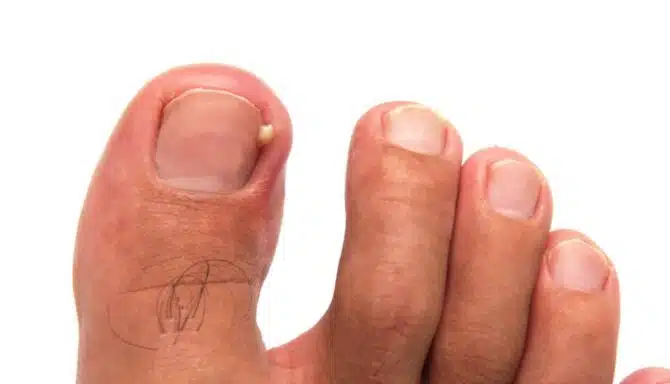September 7, 2023
Foot arch pain is a common issue that affects many individuals. The foot arch is the curved part inside your foot, consisting of several small bones, ligaments, and tendons. Various factors can cause pain in this area, and it's essential to identify the underlying cause to develop an effective treatment plan.
Foot arch pain can be frustrating, limiting mobility and challenging even simple tasks. Today, we explore the causes of foot arch pain and effective prevention and treatment strategies to help you regain footing and enjoy life without discomfort.
Read more about common causes, prevention tips, and treatment strategies for foot arch pain.
Causes of Foot Arch Pain
Flat Feet or Fallen Arches
Flat feet (sometimes called fallen arches) occur when the feet have very low or non-existent arches. Collapsed arches cause the bottom of the entire foot to contact the ground. Up to 30% of the population has flat feet, and the condition can cause strain on the ligaments and muscles in the area.
Overuse or Excessive Physical Activity
Engaging in activities that stress the feet, such as running or jumping, can lead to arch pain. High-impact or sports with repetitive movements are particularly tough on the body as they can overwork the muscles and supportive tendons in the foot. When the arch is pushed beyond its limits, you may experience pain in the region.
Plantar Fasciitis
Plantar fasciitis is a painful condition where the tissue at the bottom of your foot (the plantar fascia) becomes inflamed. It is one of the leading causes of heel and arch pain.
The condition starts with microtears from the repetitive stress of standing upright and weight-bearing. The constant stretching of the plantar fascia causes the fascia to break down, eventually leading to pain during sleep or at rest.
Achilles tendonitis
Achilles tendonitis is a condition of the tendon connecting calf muscles to the heel (the Achilles tendon). It involves inflammation of the Achilles tendon and causes pain and swelling when running or walking. Since the Achilles tendon helps support the foot, tendonitis in the back of the heel can lead to nearby arch pain.
Footwear
Wearing shoes that lack proper or have inadequate arch support can strain the arches, leading to pain. Footwear can also be used for the wrong purpose or not fit your feet correctly. Uneven weight distribution or ill-fitting footwear can stress the arch, causing pain over time.
Acute Injury or Trauma
An acute injury or trauma to the foot can cause arch pain. Injuries like a sprain, fracture, or slip and fall can damage the arch's muscles, ligaments, tendons and surroundings, leading ot arch pain.
Prevention of Foot Arch Pain
Proper Footwear
Choose shoes that provide adequate arch support and cushioning for your feet. Avoid wearing high heels or unsupportive shoes for extended periods.
Arch-Supporting Insoles or Orthotics
Consider using arch-supporting insoles or custom orthotics, especially if you have flat feet or a history of foot pain. Custom orthotics are corrective shoe inserts with moulded support for your feet. Orthotics act to correct or accommodate biomechanical abnormalities with your feet and arch to improve your gait and manage pain. The correction occurs as weight is redistributed evenly across our muscles and joints.
Gradual increase in activity
If you're starting a new exercise program or sport, gradually increase the intensity and duration to allow your feet to adapt. Doing too much too quickly can overload your feet and arch, which makes it challenging to reverse.
Maintain a healthy weight
If you're overweight, losing weight can help alleviate stress on your feet and reduce arch pain.
Stretching and strengthening exercises
Perform foot and calf stretches to maintain flexibility and strength in the foot muscles and tendons. Here are three lower leg stretching exercises that can reduce the risk of foot arch pain:
Calf Stretch: Stand facing a wall an arm's distance away, place one foot a step back, and lean towards the wall. Hold for 20-30 seconds. You should feel a light stretch in your extended leg.
Towel Curl: Sit on a chair with both feet on the floor, and place a towel before you. Using your toes, grip and curl the towel to scrunch it up. Hold for a few seconds, release, and repeat.
Plantar Fascia Stretch: Sit cross-legged on a chair, and with your hand, grab your toes and gently pull them upwards until you feel a stretch in the arch of your foot. Hold lightly for 20-30 seconds.
Treatment Strategies for Foot Arch Pain
Rest, ice, compression, elevation
Rest: Give your feet ample time to rest and avoid activities exacerbating pain.
Ice: Applying ice to the affected area can help reduce inflammation and alleviate pain. Use an ice pack for 15-20 minutes several times a day.
Compression: Use compression socks or stockings if you find inflammation and swelling build-up.
Elevation: Elevate your feet and legs above the plain of your heart to help alleviate pain and pooling.
See more about the RICE method of recovery in our blog spotlight.
Pain relief NSAIDs
Over-the-counter pain medications, such as ibuprofen or acetaminophen, can help manage pain and reduce inflammation. Reducing intense pain caused by inflammation can also help prevent longterm joint damage.
Physical Therapy
Light stretching (as outlined in the prevention section) can help increase blood flow to the area and encourage healing. However, refrain from forcing stretches, as overworking an inflamed area can exacerbate the issue. When in doubt, consult with a chiropodist on a proper treatment plan, depending on the length and severity of your discomfort.
Taping or bracing
Taping the foot or using arch-supporting braces can provide additional support during healing. Its purpose is to stabilize and reduce a joint's range of motion. At the same time, tape enables functionality in the affected area. The tape helps lock joints in place to encourage specific movements and function while reducing unwanted movements (like twisting or bending). The actual tape can be either pressure-sensitive (which activates based on the pressure applied) or something as basic as surgical tape.
Shockwave therapy
Shockwave therapy is a non-surgical treatment that utilizes high-frequency, high-energy pulses to help promote recovery and muscle repair. A chiropodist determines the frequency, pressure and number of pulses best suited for your injury and can customize the treatment based on the severity of the pain.
Night splints
A night splint can help stretch the plantar fascia and Achilles tendon, reducing morning pain associated with conditions like plantar fasciitis.
Surgery
In rare cases where conservative treatments fail, surgery may be considered for certain foot conditions. Surgery has pros and cons, as it's generally considered a last resort, so we recommend learning more about whether surgery suits your scenario.














